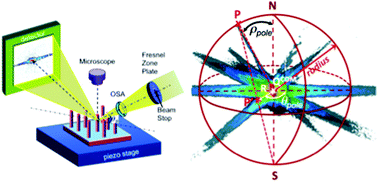Crystallographic orientation of facets and planar defects in functional nanostructures elucidated by nano-focused coherent diffractive X-ray imaging†
Abstract
The physical and chemical properties of nanostructures depend on their surface facets. Here, we exploit a pole figure approach to determine the three-dimensional orientation matrix of a nanostructure from a single Bragg reflection measured with a coherent nano-focused X-ray beam. The signature of any truncated (faceted) crystal produces a crystal truncation rod, which corresponds to a streak of intensity in reciprocal space normal to the surface. When two or more non-parallel facets are present, both the crystal orientation and the crystal facets can be identified. This enables facets to be rapidly indexed and uncommon facets, and planar defects, that have been difficult to study before to be identified. We demonstrate the technique with (i) epitaxial core–shell InGaN/GaN multiple quantum-wells grown on GaN nanowires, where surface facets and planar defects are determined, and (ii) single randomly oriented highly faceted tetrahedrahexal Pt nanoparticles. The methodology is applicable to a broad range of nanocrystals and provides a unique insight into the connection between structure and properties of nanomaterials.



 Please wait while we load your content...
Please wait while we load your content...